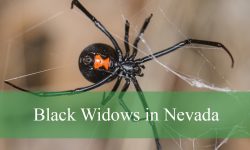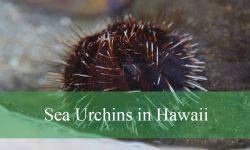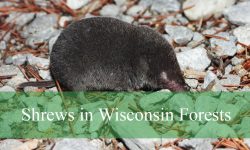Washington State hosts a rich diversity of salamanders, ranging from tiny slender species to large aquatic giants. These amphibians play a crucial role in forest and stream ecosystems, helping control insect populations and indicating environmental health.
Each species has unique characteristics, behaviors, and habitat preferences, from fully aquatic salamanders like Cope’s Giant Salamander to terrestrial species such as the Western Redback Salamander. Observing them requires understanding their preferred environments and activity patterns.
This guide explores 14 salamander species found in Washington, providing detailed identification tips, descriptions, and habitat information. It is designed for nature enthusiasts, hikers, and herpetology hobbyists who want to recognize and appreciate these fascinating amphibians.
Types of Salamanders Found in Washington
Pacific Giant Salamander (Dicamptodon tenebrosus)
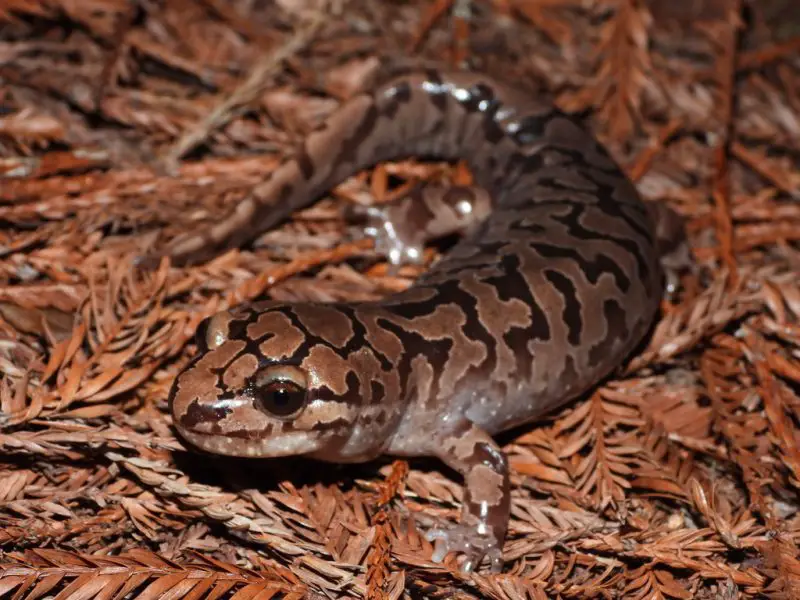
Pacific Giant Salamanders are among the largest salamanders in Washington, reaching lengths of 8–13 inches. They have robust bodies, broad heads, and strong limbs, with a distinctive mottled brown, gray, and black coloration that provides excellent camouflage in forested stream habitats. Their skin is rougher than many other salamanders, and their large eyes help them detect movement in dimly lit environments.
Identification is straightforward due to their size and patterning. They possess a wide head with prominent, slightly ridged snouts and thick, muscular tails that aid in swimming. Juveniles have external gills when in aquatic environments, which they lose as they mature. The combination of their broad head and mottled coloration makes them recognizable from other salamanders in the region.
Pacific Giant Salamanders exhibit both terrestrial and aquatic behaviors. They are nocturnal hunters, feeding on insects, worms, small invertebrates, and occasionally smaller salamanders. During the day, they typically hide under rocks, logs, or leaf litter near cool, flowing streams. Breeding occurs in water, and females lay eggs under submerged rocks or logs, where larvae develop fully before transitioning to a more terrestrial lifestyle.
These salamanders are found primarily in the wet coniferous forests of western Washington, especially along small, cold, and well-oxygenated streams. They are sensitive to habitat disturbance, including logging and stream pollution, and prefer areas with abundant cover and moist microhabitats. Their range stretches from the southern Cascades to the Olympic Peninsula, making them a key indicator species of forested stream ecosystem health.
Cope’s Giant Salamander (Dicamptodon copei)
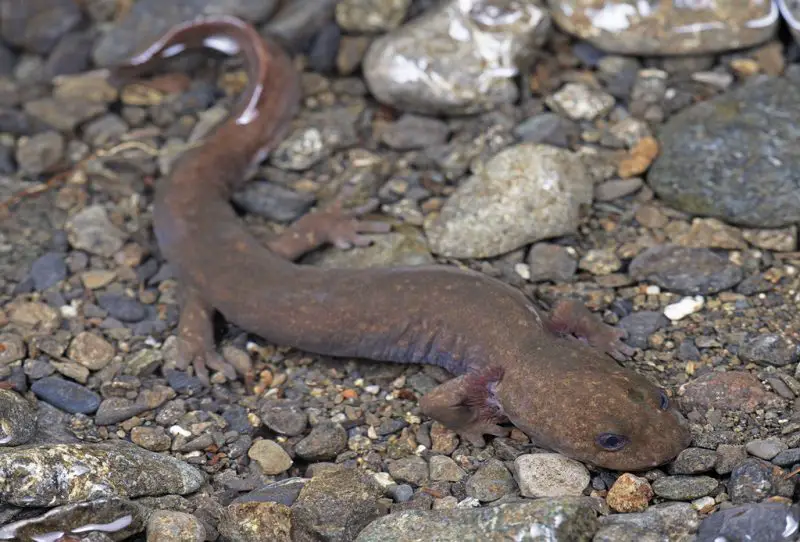
Cope’s Giant Salamanders are smaller relatives of the Pacific Giant Salamander, usually growing 3–5 inches in length. They have slender bodies and dark brown to black coloring, sometimes with faint lighter markings. Their skin is smooth and moist, and their small limbs are adapted for crawling through the leaf litter and mossy substrates of their forested habitats.
Identification relies on their smaller size compared to Pacific Giants and their aquatic tendencies. Cope’s Salamanders retain external gills well into adulthood, a rare trait called neoteny. Their heads are narrower, and eyes appear large relative to their head, giving them an alert appearance. They are often confused with juvenile Pacific Giants but remain aquatic throughout most of their life.
Behaviorally, Cope’s Salamanders are fully aquatic, rarely leaving the streams and seepage areas where they reside. They feed on small invertebrates such as insect larvae, crustaceans, and worms. Reproduction occurs underwater, with females laying eggs under submerged rocks, and larvae undergoing development without transitioning to a terrestrial phase in many cases.
Cope’s Giant Salamanders are endemic to specific areas in western Washington, primarily the Olympic Peninsula. They inhabit small, cold, clear, fast-flowing mountain streams and seepage areas with abundant moss and leaf litter. Their restricted range and habitat specificity make them vulnerable to environmental changes, particularly logging, sedimentation, and water pollution.
Northwestern Salamander (Ambystoma gracile)
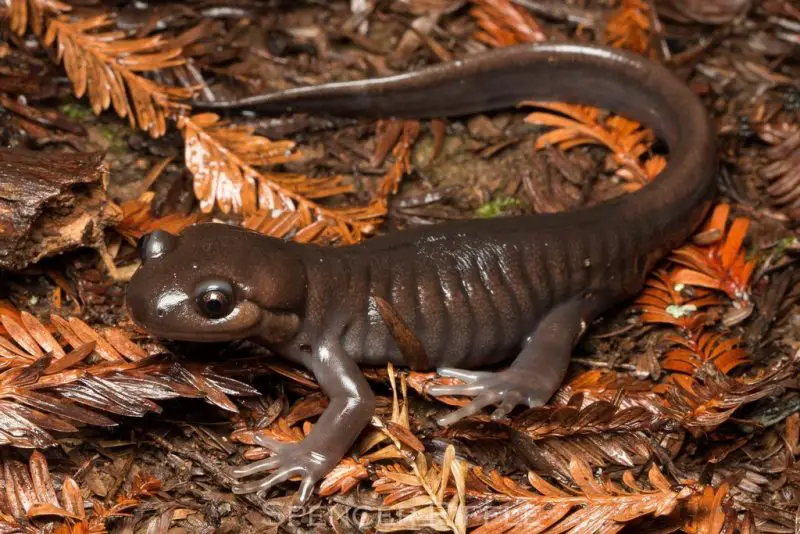
The Northwestern Salamander is a medium-sized species, growing 4–8 inches in length. They are typically dark brown to black with subtle lighter blotches along the back, which help camouflage them in forested habitats. Their heads are broad and flattened, with small, rounded snouts and relatively large eyes, adapted for their nocturnal lifestyle.
Identification can be tricky because their coloration is muted compared to other Ambystoma species, but the combination of size, blotches, and habitat preference is key. They have robust limbs for digging and burrowing, and their tails are laterally compressed to aid swimming during aquatic stages. Juveniles possess external gills while in water.
Northwestern Salamanders are versatile in behavior, exhibiting both aquatic and terrestrial phases. Adults spend much of their time underground in burrows or under logs and rocks. They emerge to feed primarily at night, preying on insects, worms, and other small invertebrates. Breeding occurs in ponds and slow-moving waters, where females lay eggs in clusters attached to vegetation or submerged debris.
This species is distributed across western Washington, from lowland forests to montane regions, often near ponds, wetlands, or slow-flowing streams. They prefer moist, shaded habitats with loose soil for burrowing. Their adaptability allows them to occupy a wide range of elevations, but they are most abundant in regions with minimal human disturbance.
Tiger Salamander (Ambystoma tigrinum)
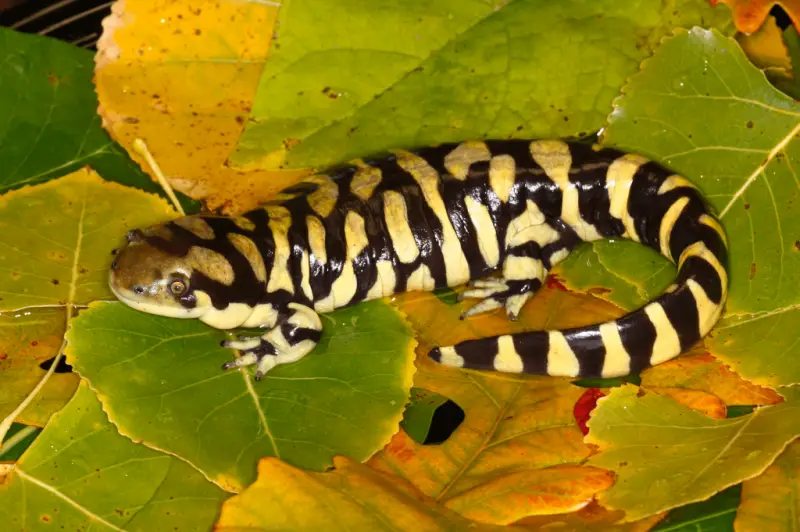
Tiger Salamanders are one of the most recognizable salamanders due to their striking patterning. Adults range from 6–14 inches in length, with a robust body and broad head. Their skin is typically dark brown or black with irregular yellow or olive stripes and spots, giving them a “tiger-like” appearance. Their strong limbs and broad tails make them effective burrowers and swimmers.
Identification is confirmed by their distinctive pattern and size. Juveniles are aquatic and have external gills, which they lose during metamorphosis. Adult Tiger Salamanders have a stocky build with a wide, rounded snout, making them distinguishable from the more slender Ambystoma species. Their eyes are prominent and golden, often reflecting light in low-light conditions.
Behaviorally, Tiger Salamanders are primarily nocturnal. They spend most of their time underground in burrows, emerging after rains to hunt insects, worms, and small amphibians. They are known for their explosive breeding migrations to temporary ponds and wetlands during rainy seasons. Eggs are laid in water, and larvae develop quickly to take advantage of ephemeral aquatic habitats.
In Washington, Tiger Salamanders are mainly found in eastern regions, favoring open grasslands, agricultural areas, and forest edges with loose, well-drained soil for burrowing. Their presence in temporary ponds and seasonal wetlands makes them susceptible to habitat loss and agricultural development. Despite this, they are considered one of the more widespread and adaptable salamanders in the state.
Long-toed Salamander (Ambystoma macrodactylum)
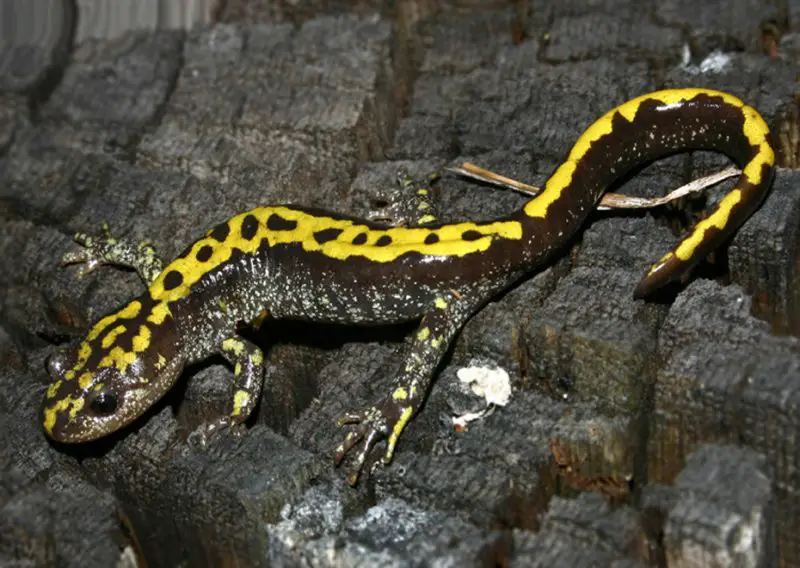
The Long-toed Salamander is a slender, medium-sized species, usually 4–8 inches long. They are typically dark brown, black, or olive, with a distinctive light stripe running down the back and a pale belly. The name “long-toed” comes from the noticeably elongated fourth toe on their hind limbs. Their skin is smooth and moist, well-suited for both terrestrial and aquatic life.
Identification is aided by their prominent dorsal stripe and long fourth toe. They have small heads with pointed snouts and large, dark eyes. During their larval stage, they have feathery external gills for aquatic respiration. Adults retain a versatile lifestyle, often moving between moist forests and nearby water sources.
Long-toed Salamanders are semi-aquatic and primarily nocturnal. They spend the day hidden under logs, rocks, or leaf litter, emerging at night to hunt insects, worms, and small invertebrates. Breeding occurs in ponds, lakes, or slow-moving streams, where females lay clusters of eggs attached to submerged vegetation. Larvae remain aquatic before metamorphosing into terrestrial adults.
This species is widely distributed across Washington, from lowland forests to high-elevation mountains. They favor moist coniferous forests near streams, ponds, and wetlands. Their adaptability allows them to inhabit a variety of microhabitats, although they require clean, unpolluted water for successful breeding and larval development.
Ensatina (Ensatina eschscholtzii)
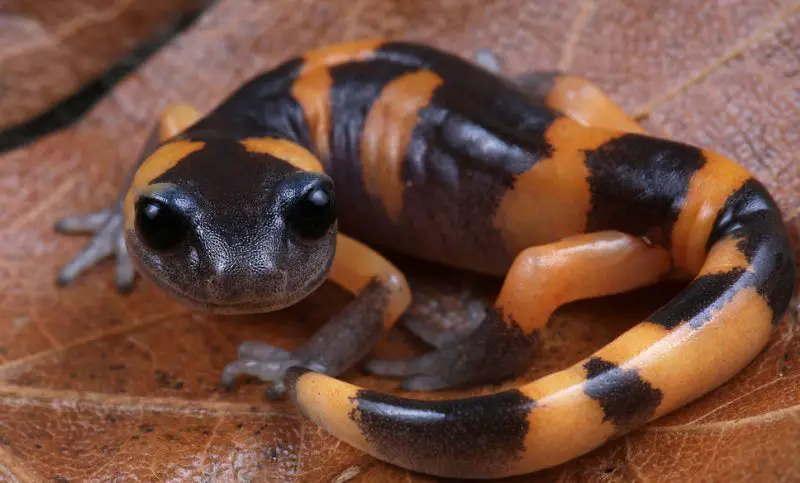
Ensatina salamanders are medium-sized, growing 4–6 inches in length. They have slender bodies with smooth skin, usually brown to reddish-brown with occasional darker spots or blotches. Their tails are long and tapering, aiding in balance and locomotion, and their heads are narrow with relatively large eyes for detecting prey in low-light conditions.
Identification relies on their characteristic coloration and body shape. Ensatinas often have a ring-like appearance in certain populations due to their polymorphic coloration patterns across different regions. Their limbs are well-developed for climbing over rocks, logs, and leaf litter. Juveniles resemble adults but are smaller and more delicate.
Ensatinas are primarily terrestrial and nocturnal. They hide under logs, rocks, and leaf litter during the day and emerge at night to hunt insects, spiders, and other small invertebrates. While they do not usually venture into aquatic environments, moist microhabitats are critical for maintaining their skin hydration and overall survival.
In Washington, Ensatinas are mostly found in the western lowlands and foothills, particularly in moist coniferous forests. They prefer shaded areas with abundant leaf litter and decaying logs. Their distribution is patchy, reflecting the localized nature of suitable moist habitats in the state.
California Slender Salamander (Batrachoseps attenuatus)
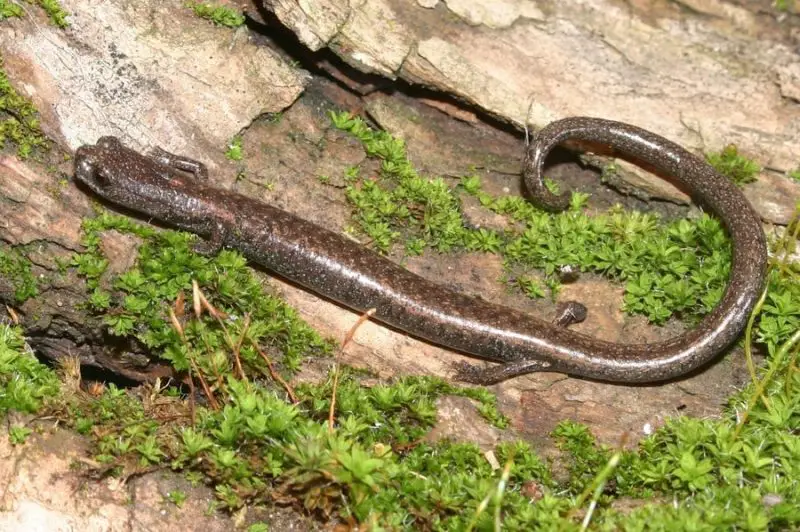
The California Slender Salamander is small and delicate, averaging 3–5 inches long. Its elongated, worm-like body and smooth, moist skin give it a distinctive appearance. Coloring ranges from brown to black with subtle lighter flecks, providing camouflage among leaf litter and soil. Limbs are tiny and slender, suitable for crawling through narrow spaces.
Identification is based on their slim, elongated body, small limbs, and small, pointed head. Unlike more robust salamanders, they lack strong musculature and broad heads. Their long, slender tail aids in locomotion, especially when navigating tight spaces under logs and stones. Juveniles look very similar to adults.
Behaviorally, California Slender Salamanders are fully terrestrial and spend most of their life underground or beneath surface debris. They feed on tiny invertebrates such as ants, mites, and springtails. Nocturnal by nature, they avoid dry conditions and are rarely seen in open daylight. Reproduction occurs under moist soil or logs, where eggs are laid in small clusters and larvae develop directly into miniature adults without an aquatic stage.
This species is restricted to the extreme southwestern parts of Washington, primarily in isolated moist forested areas. They prefer well-drained, humid soils and areas with abundant ground cover. Habitat specificity makes them sensitive to logging, soil disturbance, and drought conditions.
Oregon Slender Salamander (Batrachoseps wrighti)
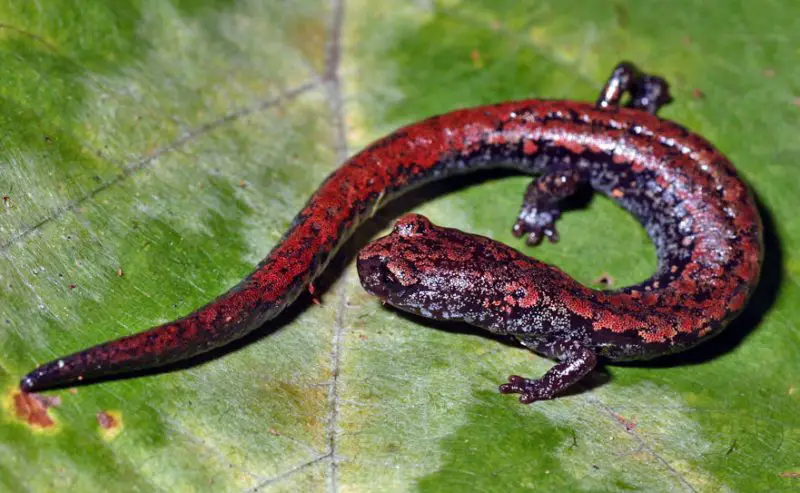
Oregon Slender Salamanders are small, reaching 3–5 inches in length, with elongated, slender bodies and smooth, moist skin. They have a dark brown to black coloration with subtle lighter speckles, helping them blend into forest floor environments. Their limbs are tiny and delicate, and their tails are long and tapering, facilitating movement through leaf litter.
Identification is based on their small size, elongated shape, and narrow head. They are very similar to the California Slender Salamander but are distinguished by subtle differences in coloration and range. Juveniles are miniature versions of adults and share the same terrestrial habits.
These salamanders are fully terrestrial and nocturnal. They forage under logs, stones, and leaf litter, preying on tiny invertebrates. Moisture is critical, and they avoid exposure to direct sunlight. Reproduction occurs beneath surface debris, where females lay eggs that undergo direct development, bypassing a free-living larval stage.
In Washington, Oregon Slender Salamanders are limited to certain moist, forested areas in the southwestern portion of the state. They thrive in microhabitats with stable humidity and abundant organic cover. Habitat loss and changes in forest moisture levels pose significant threats to local populations.
Rough-skinned Newt (Taricha granulosa)
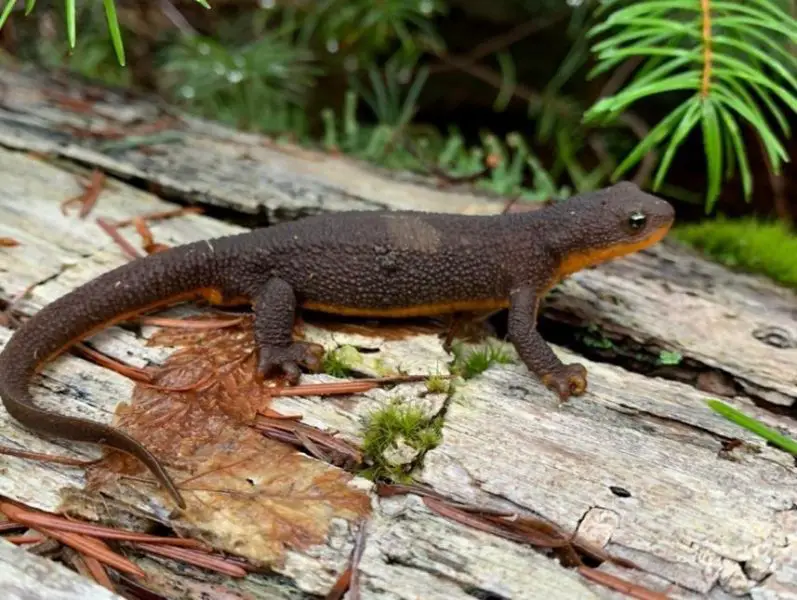
Rough-skinned Newts are medium-sized amphibians, typically 5–8 inches long. They have a distinctive rough-textured skin with brown or olive dorsal coloring and bright orange to yellow ventral surfaces, serving as a warning for their potent skin toxins. Their stocky bodies, broad heads, and rounded tails make them strong swimmers in aquatic environments.
Identification is straightforward due to their rough dorsal skin and brightly colored undersides. They have small limbs with webbed feet and a relatively short snout. Juveniles retain external gills for a short aquatic larval stage before transitioning to terrestrial juveniles. Adults often return to water for breeding.
Behaviorally, Rough-skinned Newts alternate between terrestrial and aquatic habitats. During the day, they hide under logs, rocks, and leaf litter, emerging at night to feed on insects, worms, and small invertebrates. Breeding occurs in ponds and slow-moving streams, where eggs are attached to submerged vegetation. They exhibit aposematic coloration to deter predators due to their tetrodotoxin production.
Rough-skinned Newts are widely distributed across Washington, particularly in western regions. They inhabit moist forests, wetlands, ponds, and slow-flowing streams. Their preference for clean, undisturbed aquatic and terrestrial habitats makes them good indicators of ecosystem health.
Red-bellied Newt (Taricha rivularis)
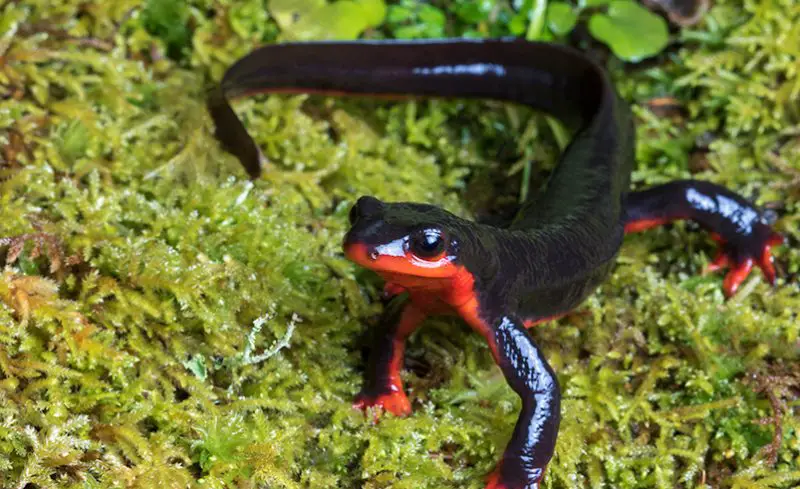
Red-bellied Newts are medium-sized, averaging 5–7 inches in length, with smooth, dark brown or black dorsal skin and vivid red or orange ventral surfaces. Their rounded bodies, broad heads, and muscular tails aid in both swimming and terrestrial locomotion. Like other Taricha species, they produce toxins that protect them from predators.
Identification is primarily based on the bright red belly, rough dorsal texture, and moderate size. They have small limbs with webbed toes, short snouts, and large eyes adapted for both terrestrial and aquatic environments. Juveniles are aquatic, with external gills that they lose as they metamorphose.
Red-bellied Newts are semi-aquatic, spending part of their lives in streams or ponds and part on land. Nocturnal hunters, they feed on small invertebrates, and during the breeding season, they migrate to water for reproduction. Eggs are laid under rocks or attached to submerged vegetation, and larvae develop in water before transforming into terrestrial juveniles.
In Washington, Red-bellied Newts are rare and mostly found in the westernmost forests and near the Olympic Peninsula. They inhabit cold, clear, well-oxygenated streams with abundant cover. Their limited distribution and specialized habitat requirements make them sensitive to environmental disturbances and water pollution.
Western Redback Salamander (Plethodon vehiculum)
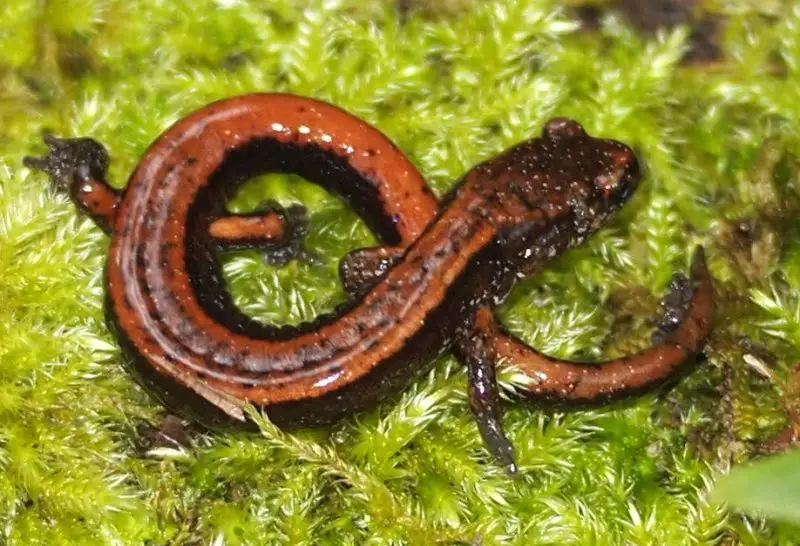
Western Redback Salamanders are small, averaging 3–5 inches in length, with slender bodies and smooth, moist skin. Their most distinguishing feature is a narrow red, orange, or yellow stripe running down the back against a dark brown or black background. Their tails are long and tapering, and their limbs are well-developed for crawling over logs and leaf litter.
Identification is straightforward due to the characteristic dorsal stripe. They have narrow heads, rounded snouts, and relatively large eyes, which aid in nocturnal hunting. Juveniles closely resemble adults but may have slightly less vivid dorsal coloring. Their small size and stripe make them distinguishable from other Plethodon species in Washington.
Behaviorally, Western Redback Salamanders are terrestrial and nocturnal. They spend the day hidden under rocks, logs, or leaf litter and emerge at night to feed on insects, spiders, and other small invertebrates. Moisture is critical for their survival, and they avoid dry conditions. Breeding occurs on land, where eggs are laid in moist soil or under logs and develop directly into juvenile salamanders without an aquatic larval stage.
In Washington, this species is widely distributed in western forests, particularly in lowland and montane coniferous forests. They prefer shaded, moist habitats with abundant leaf litter and decaying wood. Their presence often indicates a healthy, undisturbed forest ecosystem.
Coastal/Western Slimy Salamander (Plethodon stormi)
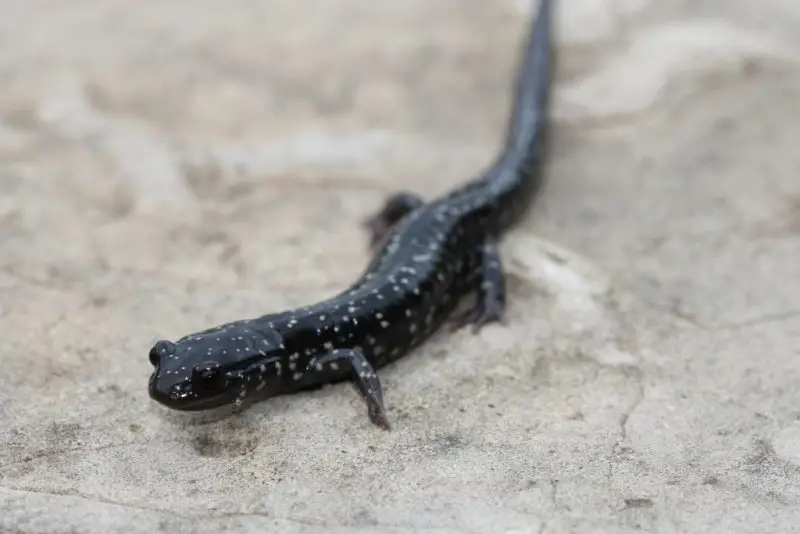
Coastal Slimy Salamanders are small, ranging from 3–5 inches in length, with robust yet slender bodies. Their dark black or brown skin is coated with sticky secretions, which serve as a defense against predators. They have long, tapering tails and sturdy limbs, adapted for crawling through forest floor debris and under logs.
Identification is based on their sticky skin, dark coloration, and terrestrial habits. They have broad heads with rounded snouts and large eyes. Juveniles look similar to adults but are smaller and less robust. Their distinctive skin secretions often leave a shiny, wet appearance when handled.
Behaviorally, they are nocturnal and spend most of their time hidden under logs, rocks, or leaf litter, emerging at night to hunt insects, worms, and other small invertebrates. They are highly sensitive to environmental moisture and rarely venture into dry areas. Breeding occurs entirely on land, with eggs laid in moist soil or decaying wood, bypassing an aquatic larval stage.
In Washington, Coastal Slimy Salamanders are limited to moist western lowland forests, often near the Olympic Peninsula. They require stable humidity and dense forest cover, making them sensitive to logging and habitat fragmentation. Their localized distribution makes them an important species for conservation monitoring.
Van Dyke’s Salamander (Plethodon vandykei)
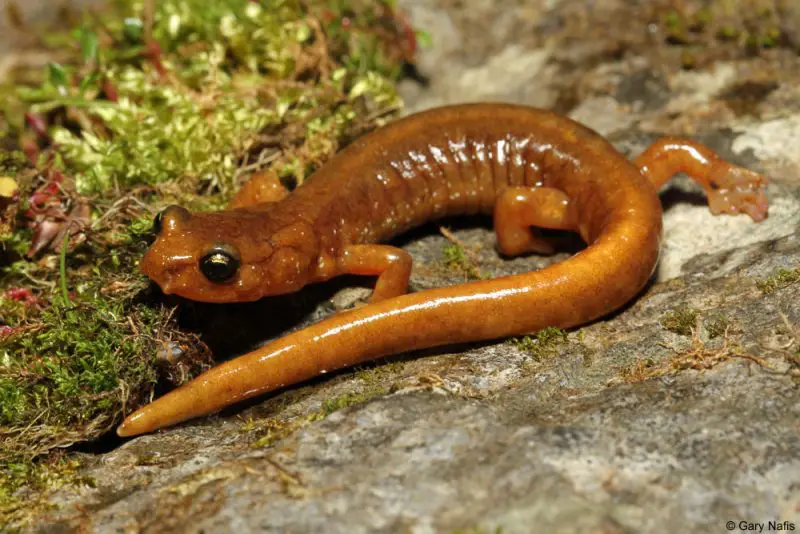
Van Dyke’s Salamanders are small, measuring 3–4 inches in length, with slender bodies and smooth, moist skin. They are typically dark brown or black, sometimes with subtle reddish or orange dorsal streaks. Their tails are long and tapering, and their small limbs are adapted for terrestrial locomotion through leaf litter and moss.
Identification is aided by their small size, narrow head, and subtle dorsal markings. They have rounded snouts and large eyes for nocturnal hunting. Juveniles resemble adults but are slightly smaller and more delicate. This species is often confused with other Plethodon salamanders but is distinguished by its range and subtle coloration.
Behaviorally, Van Dyke’s Salamanders are terrestrial and nocturnal, spending the day under logs, rocks, or leaf litter. They feed on insects, spiders, and other invertebrates and require consistently moist habitats. Breeding occurs on land, with eggs laid in moist soil or decaying wood, and direct development eliminates the need for an aquatic larval stage.
Van Dyke’s Salamanders are endemic to western Washington, particularly in the Puget Sound region and the Olympic Peninsula. They inhabit moist, shaded forests with abundant cover and leaf litter. Their sensitivity to habitat disturbance makes them vulnerable to logging and urbanization.
Olympic Salamander (Rhyacotriton olympicus)
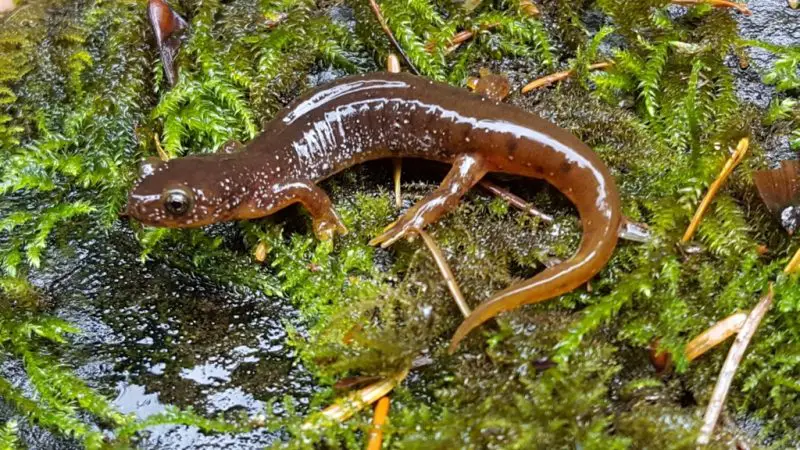
Olympic Salamanders are small, growing 2.5–4 inches in length, with slender, delicate bodies and smooth skin. Their coloration ranges from dark brown to black, with lighter mottling on the back. They have small limbs, a long tapering tail, and a narrow head, adapted for navigating the rocky substrates of streams and moist forest floors.
Identification is based on their small size, narrow body, and habitat preferences. They are often found under moss-covered rocks or leaf litter near cold, fast-flowing streams. Juveniles resemble adults but have more pronounced mottling, and all life stages are primarily terrestrial but closely tied to aquatic environments for breeding.
Behaviorally, Olympic Salamanders are nocturnal and semi-aquatic. They feed on small invertebrates and remain close to moist microhabitats, hiding under rocks and logs during the day. Reproduction occurs in shallow, cold streams where females attach eggs to submerged rocks. Larvae develop fully in water before transitioning to the forest floor as juveniles.
In Washington, they are endemic to the Olympic Peninsula and nearby western coastal forests. They require cold, clean, well-oxygenated streams and adjacent moist forest habitats. Their restricted range and sensitivity to habitat disturbance make them an important conservation species.
FAQs about Salamanders in Washington
What types of salamanders are found in Washington?
Washington is home to a diverse range of salamanders, including 15 notable species such as the Pacific Giant Salamander, Cope’s Giant Salamander, Northwestern Salamander, Tiger Salamander, Long-toed Salamander, Ensatina, Rough-skinned Newt, Red-bellied Newt, and several slender and redback salamanders. These species inhabit forests, streams, wetlands, and mountainous areas across the state.
Where do Pacific Giant Salamanders live in Washington?
Pacific Giant Salamanders primarily inhabit western Washington’s moist coniferous forests. They are closely associated with cold, flowing streams, under rocks, and logs, which provide shelter and breeding grounds. They are sensitive to habitat disturbance, including logging and pollution.
Are any salamanders in Washington fully aquatic?
Yes. Cope’s Giant Salamander is fully aquatic throughout its life and retains external gills as an adult—a condition called neoteny. Rough-skinned Newts and Red-bellied Newts also spend part of their life cycle in water, particularly during breeding. Most other species are semi-aquatic or terrestrial.
How can I identify a Long-toed Salamander?
Long-toed Salamanders are medium-sized (4–8 inches) and recognizable by a light dorsal stripe running down their dark brown or black body. They also have a noticeably long fourth toe on the hind limbs. They are typically found near ponds, streams, and moist forest habitats.
Are any salamanders in Washington endangered?
Several salamanders, such as Cope’s Giant Salamander and Olympic Salamander, have restricted ranges and specialized habitat needs, making them vulnerable to habitat destruction. Conservation of cold streams, moist forests, and undisturbed microhabitats is critical for their survival.
Do Washington salamanders pose any danger to humans?
No. While species like Rough-skinned Newts and Red-bellied Newts produce toxins to deter predators, they are not dangerous if handled carefully. It is best to wash hands after contact and avoid ingestion. These salamanders are more beneficial than harmful, playing an important role in controlling insect populations.
When is the best time to see salamanders in Washington?
Salamanders are most active during moist conditions, particularly in spring and fall. Nighttime is ideal for observation, as most species are nocturnal. After rains, they often emerge from hiding under logs, rocks, and leaf litter.
What should I do if I find a salamander in my yard?
If you find a salamander, leave it undisturbed or gently relocate it to a nearby moist, shaded area. Avoid exposing it to direct sunlight, chemicals, or extreme heat. Providing leaf litter, logs, or damp garden areas can support salamanders in urban or suburban yards.



